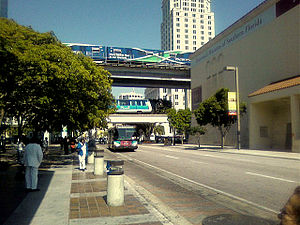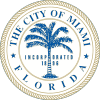
METRORail is the 22.7-mile (36.5 km) light rail system in Houston, Texas. In 2022, the system had a ridership of 12,176,700, or about 44,300 per weekday as of the third quarter of 2023. METRORail ranks as the second most-traveled light rail system in the Southern United States and the 12th most-traveled light rail system in the United States, and has the highest ridership per mile for light rail systems in the Southern US. METRORail is operated by the Metropolitan Transit Authority of Harris County (METRO).
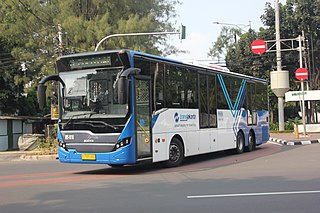
Bus rapid transit (BRT), also referred to as a busway or transitway, is a bus-based public transport system designed to have much more capacity, reliability and other quality features than a conventional bus system. Typically, a BRT system includes roadways that are dedicated to buses, and gives priority to buses at intersections where buses may interact with other traffic; alongside design features to reduce delays caused by passengers boarding or leaving buses, or paying fares. BRT aims to combine the capacity and speed of a light rail transit (LRT) or mass rapid transit (MRT) system with the flexibility, lower cost and simplicity of a bus system.
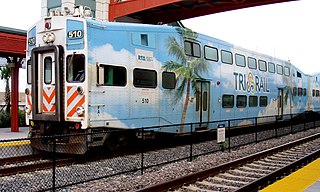
Tri-Rail is a commuter rail service linking Miami, Fort Lauderdale and West Palm Beach in Florida, United States. The Tri prefix in the name refers to the three counties served by the railroad: Palm Beach, Broward, and Miami-Dade. Tri-Rail is managed by the South Florida Regional Transportation Authority (SFRTA) along CSX Transportation's former Miami Subdivision; the line is now wholly owned by the Florida DOT. The 80.0-mile-long (128.7 km) system has 19 stations along the Southeast Florida coast, and connects directly to Amtrak at numerous stations, to Metrorail at the Tri-Rail and Metrorail Transfer station, Miami Intermodal Center, and MiamiCentral, and to Brightline at MiamiCentral.

Metromover is an automated people mover system operated by Miami-Dade Transit in Miami, Florida, United States. Metromover serves the Downtown Miami, Brickell, Park West and Arts & Entertainment District neighborhoods. Metromover connects directly with Metrorail at Government Center and Brickell stations. It also connects to Metrobus with dedicated bus loops at Government Center and Adrienne Arsht Center station. It originally began service to the Downtown/Inner Loop on April 17, 1986, and was later expanded with the Omni and Brickell Loop extensions on May 26, 1994.

Palmetto station is a Metrorail rapid transit station in unincorporated Miami-Dade County, Florida, United States, just near the town of Medley. It is the current northern terminus of the Metrorail system. This station is located near the intersection of Northwest 77th Street and 79 Avenue, opening to service May 30, 2003. It is adjacent to the Palmetto Expressway, providing convenience to west Miami-Dade and Broward commuters traveling into Downtown Miami. The station is in a low-density warehouse area and has low ridership. In 2023 a 900-unit housing project was proposed for the site.900 apartments
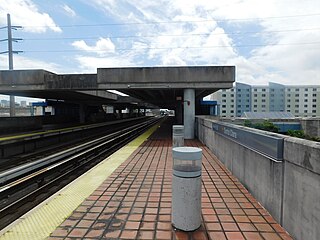
Santa Clara station is a station on the Metrorail rapid transit system in the industrial district of the Allapattah neighborhood in Miami, Florida. This station is located near the intersection of Northwest 12th Avenue and 20th Street. It opened to service December 17, 1984. Along with Brownsville station, Santa Clara is generally the lowest ridership station on the system.

Government Center station is an intermodal transit hub in the Government Center district of Downtown Miami, Florida. It is operated by Miami-Dade Transit and serves as a transfer station for the Metrorail and Metromover rapid transit systems and as a bus station for Metrobus, Paratransit, and Broward County Transit buses. MiamiCentral is directly connected via a pedestrian bridge over NW 3rd Street. The station is located near the intersection of Northwest First Street and First Avenue, a part of the Stephen P. Clark Government Center Building. It opened to service May 20, 1984, next to the site of a former FEC railway station which is now MiamiCentral.

Brickell station is a Metrorail rapid transit station in Miami, Florida, serving the system's Green and Orange Lines. One of the core stations of Miami's public transport network, it serves the financial district of Brickell. Combined, the Metrorail and Metromover station complex at Brickell sees roughly 8,430 boardings each weekday, making it the system's second-busiest station.

Dadeland South station is a transfer station on the Metrorail rapid transit system in the Dadeland district of Kendall, Florida. It is the southern terminus of the Metrorail system and the northern terminus of the South Dade TransitWay. It is the southernmost passenger rail station in the Continental United States. This station is located near the intersection of Dadeland Boulevard and Datran Boulevard, adjacent to South Dixie Highway, three blocks southwest of Kendall Drive and Dadeland Mall, and just east of the US 1–Palmetto Expressway junction. It opened to service May 20, 1984.

The Interurban Transit Partnership, branded as The Rapid, is the public transit operator serving Grand Rapids, Michigan and its suburbs. In 2022, the system had a ridership of 5,106,600, or about 19,800 per weekday.

Miami Intermodal Center (MIC) is an intermodal rapid transit, commuter rail, intercity rail, local bus, and intercity bus transportation hub in Miami-Dade County, Florida, just outside the Miami city limits near the Grapeland Heights neighborhood. The facility was constructed by the Florida Department of Transportation and is owned by the Miami-Dade Expressway Authority.

Metrorail is a rapid transit system in Miami and Miami-Dade County in the U.S. state of Florida. Metrorail is operated by Miami-Dade Transit (MDT), a departmental agency of Miami-Dade County. Opened in 1984, it is Florida's only rapid transit metro system, and is currently composed of two lines of 23 stations on 24.4 miles (39.3 km) of standard gauge track. Metrorail serves the urban core of Miami, connecting Miami International Airport, the Health District, Downtown Miami, and Brickell with the northern developed neighborhoods of Hialeah and Medley to the northwest, and to suburban The Roads, Coconut Grove, Coral Gables, and South Miami, ending at urban Dadeland in Kendall. Metrorail connects to the Metromover in Downtown, which provides metro service to the entirety of Downtown and Brickell. Additionally, it connects to South Florida's commuter rail system at Tri-Rail station, as well as Metrobus routes at all stations. In 2022, the system had 11,951,400 rides, and about 45,400 per day in the third quarter of 2023.
Transportation in Florida includes a variety of options, including Interstate Highways, U.S. Highways, and Florida State Roads; Amtrak and commuter rail services; airports, public transportation, and sea ports, in a number of the state's counties and regions.

Government Center is a district in the western portion of downtown Miami, Florida bound roughly by I-95 and West (NW/SW) 3rd Avenue to the west, South (SW/SE) 1st Street to the south, North (NE/NW) 5th Street to the north, and East (NE/SE) 1st Avenue to the east.

The Easy Card system is a series of linked contactless smartcard systems used by Miami-Dade Transit and South Florida Regional Transportation Authority in the South Florida area. The Easy Card allows for electronic payment on multiple public transport systems including Miami Metrorail, rapid transit rail system; Tri-Rail, commuter rail system; and Metrobus. Other public transportation agencies in the South Florida area which may eventually join the system include Broward County Transit as well as Palm Tran.

The Greater Miami area, composed of the three counties of Miami-Dade, Broward, and Palm Beach, also known collectively as South Florida, is home to a wide variety of public and private transportation systems. These include heavy rail mass transit (Metrorail), commuter rail (Tri-Rail), automated guideway transit (Metromover), highways, two major airports and seaports, as well as three county-wide bus networks, which cover the entire urbanized area of South Florida. Census and ridership data show that Miami has the highest public transportation usage of any city in Florida, as about 17% of Miamians use public transportation on a regular basis, compared to about 4% of commuters in the South Florida metropolitan area. The majority of public transportation in Miami is operated by Miami-Dade Transit (MDT), which is currently the largest transit system in Florida and was the 14th largest transit system in the United States in 2011.
BayLink is a long-proposed transit connection between Miami and Miami Beach, Florida. Proposals have ranged from streetcar, light rail, monorail, Metromover, or Metrorail extension that would connect Downtown Miami to South Beach via the MacArthur Causeway, with the light rail or streetcar options potentially having loops at both ends. In 2020, the project was previously approved by commissioners as Miami Beach Monorail, a $770 million public-private partnership project connecting 5th Street in South Beach to Metromover on the mainland at the Genting property in Omni. In November 2022, the project would be changed to Metromover because the budget did not allow for the proposed monorail and it would not provide a one-seat ride from Downtown Miami to South Beach.

The Metrobus network provides bus service throughout Miami-Dade County 365 days a year, operated by Miami-Dade Transit. It consists of about 93 routes and 893 buses, which connect most points in the county and part of southern Broward County as well. As of 2022, the system has 41,854,200 rides per year, or about 175,600 per day in the third quarter of 2023.

The Metro C Line is a bus rapid transit line in Brooklyn Center and Minneapolis, Minnesota operated by Metro Transit. The line is part of Metro Transit's Metro network of light rail and bus rapid transit lines. The route operates from the Brooklyn Center Transit Center along Penn Avenue and Olson Memorial Highway, terminating in downtown Minneapolis. The route is analogous to the existing Route 19 and is projected to increase ridership on this corridor from 7,000 to 9,000 by 2030. Eventually, part of its route will shift south to Glenwood Avenue from Olson Memorial Highway.
